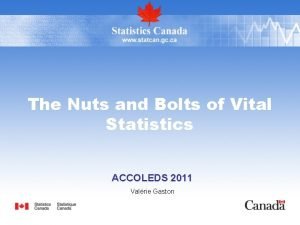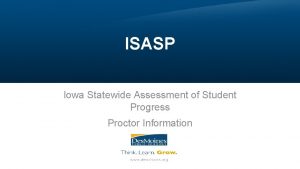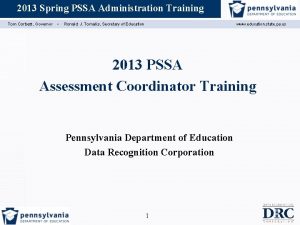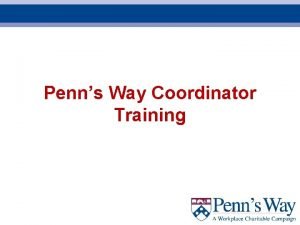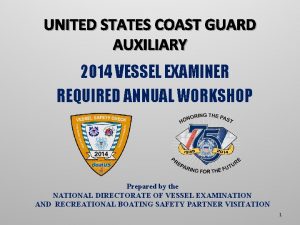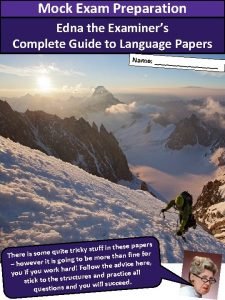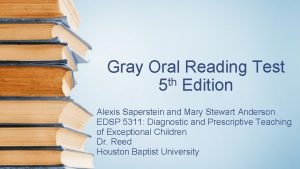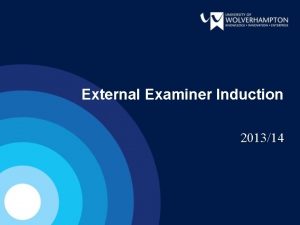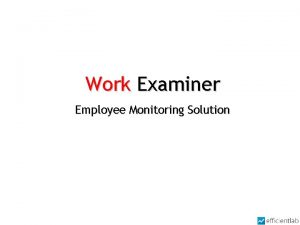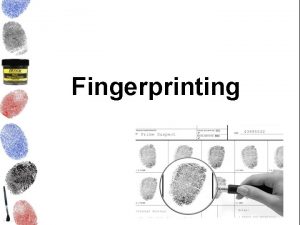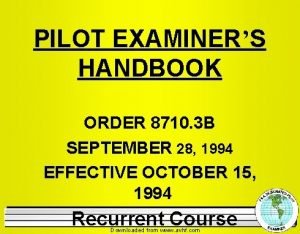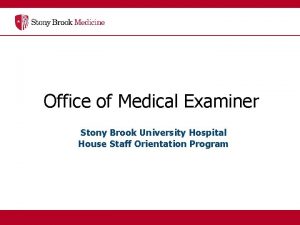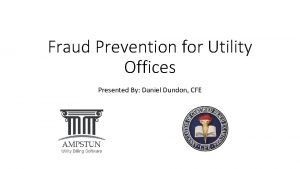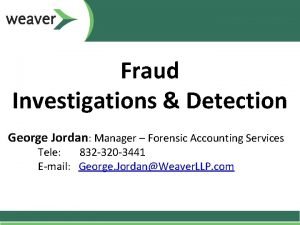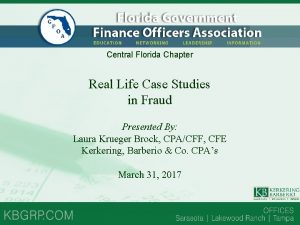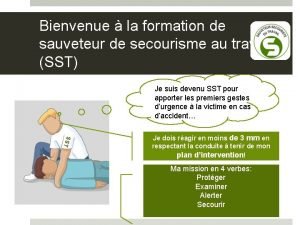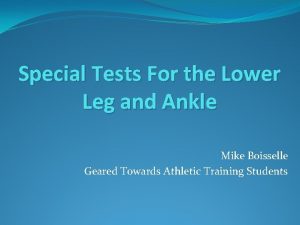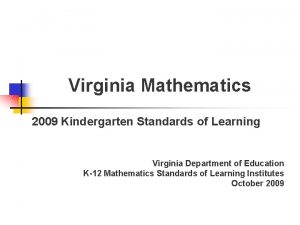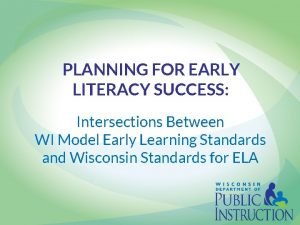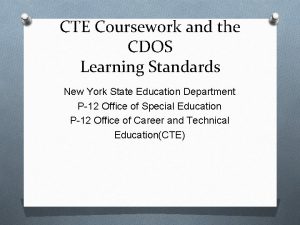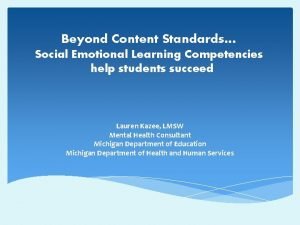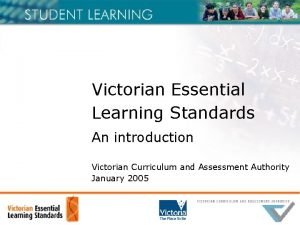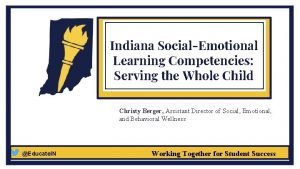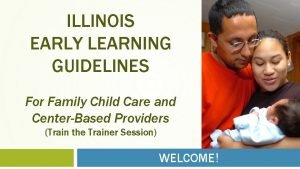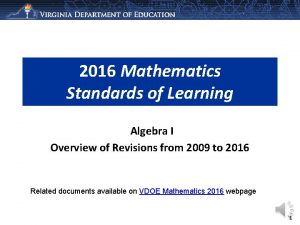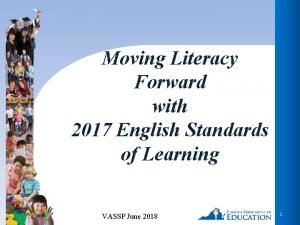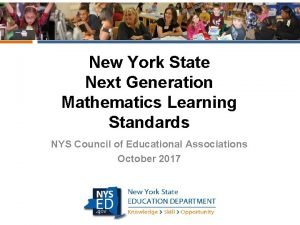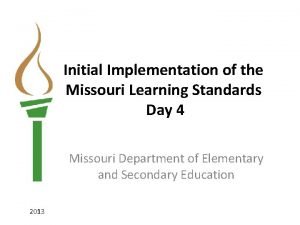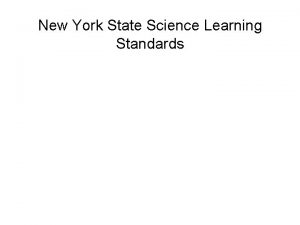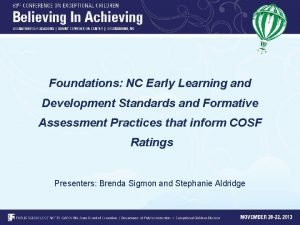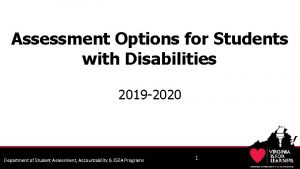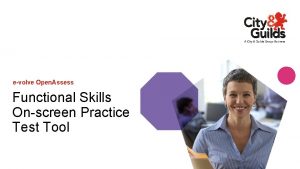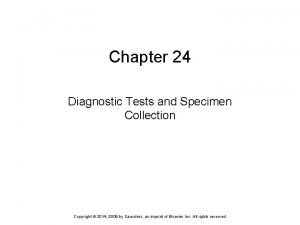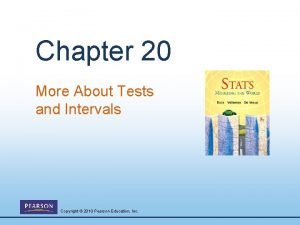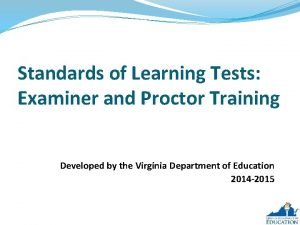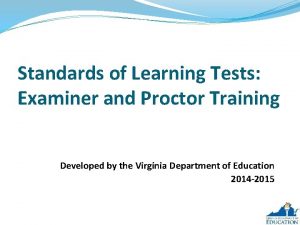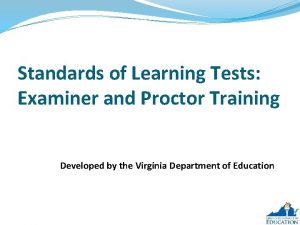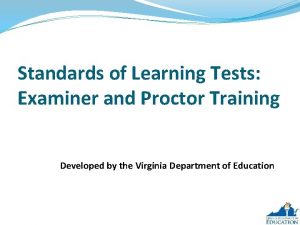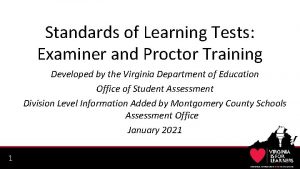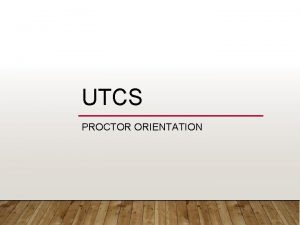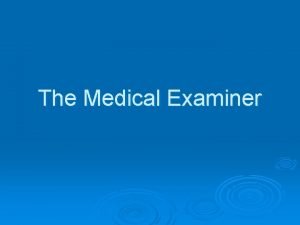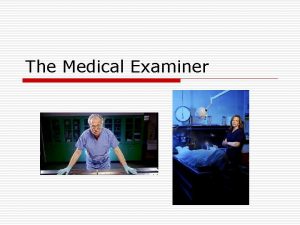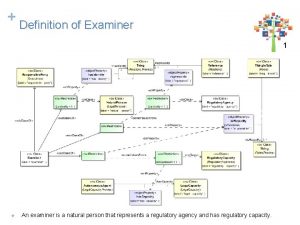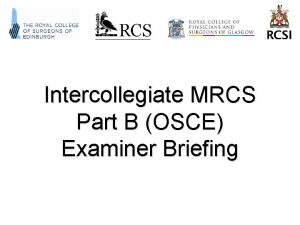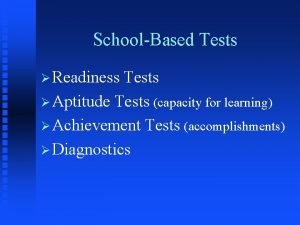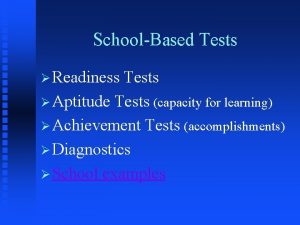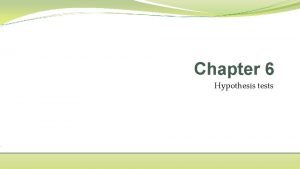Standards of Learning Tests Examiner and Proctor Training



















































- Slides: 51

Standards of Learning Tests: Examiner and Proctor Training Developed by the Virginia Department of Education 2016 -2017

Examiners and Proctors What is the difference between an examiner and a proctor for Standards of Learning (SOL) testing? As defined in the Examiner’s Manual: An “Examiner” is responsible for administering the SOL tests according to the procedures outlined in the Examiner’s Manual and for maintaining security of test materials. Training for Examiners 2014 -2015 2

Examiners and Proctors As defined in the Examiner’s Manual: A “Proctor” works with the examiner in administering the SOL tests and assists in maintaining an appropriate testing environment. A proctor may be called upon to verify that: • the test was administered according to the procedures outlined in the Examiner’s Manual, • the security of test materials was maintained, and • students did not receive inappropriate assistance on the test. Training for Examiners 2014 -2015 3

Examiners and Proctors The training expectations for SOL test examiners and SOL test proctors are the same. Training for Examiners 2014 -2015 4

Examiners’ Responsibilities and Activities: Before SOL Testing Training for Examiners 2014 -2015 5

SOL Test Security All examiners and proctors must: Read the Virginia law regarding the consequences of violating test security procedures, including: Actions for violations of test security procedures (§ 22. 1– 19. 1) Violation of test security procedures: Revocation of license (§ 22. 1– 292. 1) Read, understand, and sign the School Division Personnel Test Security Agreement. Ask all questions before signing. Questions should be directed to the School Test Coordinator (STC). Training for Examiners 2014 -2015 6

Electronic Devices Cell phones fall under “Acceptable Computer Use” policy and failure to follow Student Code of Ethics for Digital Resources may result in academic sanctions, loss of privileges, disciplinary action, and/or confiscation of device (returned only to student’s parent). * During SOL testing, students may NOT access any electronic devices, including but not limited to cell phones, e-books, tablets, games, etc. For added security during testing, these devices should be turned in to examiner prior to testing. * Consequences of accessing electronic devices during testing must be discussed with students before testing. Teachers of SOL-tested courses should refer to pre-testing discussion notes to share with students. * Any incident in which a student accesses an electronic device during SOL testing is an irregularity and must be reported immediately to your STC. Training for Examiners 2014 -2015 7

Cheating Students are expected to perform honestly on schoolwork and tests. The following actions are prohibited: * Cheating on a test or assigned work by giving, receiving, offering and/or soliciting information Plagiarizing by copying the language, structure, idea and/or thoughts of another Falsifying statements on any assigned school document The consequences of cheating on the test must be discussed with students before testing. Teachers of SOL-tested courses should refer to pre-testing discussion notes to share with students. * Any incident in which a student is suspected of cheating must be reported immediately to your STC. Training for Examiners 2014 -2015 8

Manuals for Test Administration Examiners and proctors must be provided with their own copies of the appropriate manual(s) during training. This could include: Examiner’s Manual for each test being administered Supplement to the Examiner’s Manual (for the administration of paper tests) Guidelines for Administering the Read-Aloud Accommodation for Standards of Learning Assessments (if the Read-Aloud form of a test is being administered) Training for Examiners 2014 -2015 9

Manuals for Test Administration Examiners and proctors are expected to read each manual that pertains to the test being administered prior to the day of testing. Read each manual early so that ample time is available to ask the STC all questions that arise. Examiners and proctors are encouraged to “mark-up” their manuals in order to deliver the directions to the students in the clearest possible way. Regardless of an examiner’s or proctor’s previous experience with SOL testing, there is no substitute for reading the manuals. Training for Examiners 2014 -2015 10

Testing Materials Know the process for receiving secure testing materials from your STC. * Counting and checking that you have all required materials takes time, so plan accordingly. Secure testing materials may include test tickets, test booklets, or writing prompts. Non-secure testing materials are listed in each Examiner’s Manual and vary by test. Examples may include unused scratch paper, pencil or pen, etc. Know what you should expect to receive for the student(s) you are responsible for testing. Training for Examiners 2014 -2015 11

Secure Testing Materials Examiners must count all secure testing materials issued. Examiners must sign a transmittal form after verifying the amount of secure materials received. If there is a discrepancy between what is listed on the transmittal form and what the Examiner counts, adjustments must be made prior to signing the transmittal form. Training for Examiners 2014 -2015 12

Testing Materials: Calculators NW If you will administer a test for which students are allowed a hand-held calculator, know whether the school or student will supply the calculator. * The Examiner’s Manuals list those tests that permit a hand-held calculator and the state-approved calculators for each test. Calculators must be prepared following the guidelines in the Examiner’s Manual prior to testing. Guidelines include directions for clearing memory and list allowable applications for specific calculator models. Training for Examiners 2014 -2015 13

Testing Materials: Calculators NW For the Grades 4, 5, 6, and 7 Mathematics tests, the state-approved hand-held calculator is distributed to students ONLY upon entering Section 2 of the test. Student access to a calculator during Section 1 or not having access to a calculator during Section 2 of these tests is a testing irregularity. Training for Examiners 2014 -2015 14

Testing Materials: Calculators NW If students are expected to supply or are permitted to use their own calculators, you need to know: how your school will ensure that each calculator is a state -approved calculator for use during SOL testing; how your school will ensure that each calculator has been prepared following the guidelines in the Examiner’s Manual; and your school’s plan for providing a state-approved and prepared calculator to students who need them at any point during testing (ex. student does not bring a calculator, calculator stops working, student brings a calculator that is not approved for use). Training for Examiners 2014 -2015 15

Testing Materials: Calculators NW Examiners play a critical role in ensuring that students have a state-approved calculator that has been appropriately cleared prior to testing. Permitting a student to test with a non state-approved calculator or with a state-approved calculator that has not been prepared according to the state-prescribed procedures is a testing irregularity. Training for Examiners 2014 -2015 16

Test Site Preparation Remove or cover all curricular materials related to test content and test-taking strategies that might influence student performance or provide an unfair advantage to students. These materials include but are not limited to: class notes, study guides, maps, timelines, graphic organizers, charts, posters, projections, computer programs, textbooks, dry-erase board displays, chalk board displays, bulletin board displays, etc. Placing physical barriers, free of any writing or graphics, between workstations is helpful in preventing students from viewing each other’s computer monitors. Training for Examiners 2014 -2015 17

Test Site Preparation Testing rooms should be quiet, well lighted, and well ventilated. Report problems to the STC. Each student’s work space should be clear of books and other materials not required for the test and large enough to accommodate required testing materials. Plan appropriately to avoid overcrowding. Seating should be arranged to discourage students from viewing or copying one another’s work and from communicating with one another during testing. Students must not have access to cell phones or other devices that are capable of providing an advantage. Training for Examiners 2014 -2015 18

Accommodations for Students Examiners should be familiar with any special testing accommodations required for each student in the testing group prior to the day of testing. For many students special testing accommodations vary by test. It is important to provide accommodations that are needed for the specific test being administered each day. Coordinate with the STC how special test accommodations will be provided to students in the testing group. Descriptions of special test accommodations are included in each Examiner’s Manual. Training for Examiners 2014 -2015 19

School Testing Schedule Examiners should be aware of the overall testing schedule in their building. Based on the schedule in their school, examiners should review the procedures outlined in the Examiner’s Manual. Breaks that are student-initiated For tests with two sections: Breaks between test sections (individual vs. whole group) Administering the test over two days, if applicable Training for Examiners 2014 -2015 20

Procedures for Contacting STC Know the procedure for contacting the STC during testing. The STC will describe the procedure and provide examples of situations for which he or she should be contacted. Training for Examiners 2014 -2015 21

Remember… Read all the manuals issued to you. Ask questions before the morning of testing if at all possible. If you are unsure of any policies and procedures, ask the STC for guidance. If you are unsure of how to handle a situation that arises during testing, stop and ask the STC for guidance rather than allowing students to continue testing. There is no substitute for reading the manuals. Training for Examiners 2014 -2015 22

Examiners’ Responsibilities and Activities: During SOL Testing Training for Examiners 2014 -2015 23

Contacting the STC If a situation occurs in which you must contact the STC during testing, the integrity of the testing environment must be maintained in order for testing to continue. If you are unsure of how to handle a situation that arises during testing, stop and ask the STC for guidance rather than allowing students to continue testing. Training for Examiners 2014 -2015 24

Test Site Preparation To help prevent irregularities, carefully check the test room on the day of testing before distributing any test materials to students. Do not assume the test sites are ready, including rooms used for extended testing. Ensure the test site is ready for testing, even if the room was used previously to administer tests to students. Ensure all rooms used for testing have been properly prepared so that test-taking strategies and content information are not visible. It may be helpful to place a “Testing: DO NOT DISTURB” sign on the door. Training for Examiners 2014 -2015 25

Test Site Preparation Arrange seating to discourage students from viewing or copying one another’s work and from communicating with one another. Examiners must ensure students do not have access to unauthorized materials within the room or in desks. Make sure all desks/workstations are clear of all materials not needed/authorized for testing. Have students place book bags and other materials away from the desks/workstations. Make sure students do not have access to cell phones or other electronic devices. Training for Examiners 2014 -2015 26

Getting Started Read the directions for students (in bold type) from the Examiner’s Manual exactly as written. If a mistake is made in reading a direction, use the verbiage provided in the Examiner’s Manual, then read the direction again. Unless otherwise noted in the Troubleshooting section of the Examiner’s Manual, examiners must not touch a student’s mouse, keyboard, or computer screen. Problems with technology should be reported to the STC. No one, besides the student, must ever use a student’s test ticket to log in to Test. Nav for any reason. Training for Examiners 2014 -2015 27

Distributing Test Materials Distribute the test materials exactly as prescribed in the Examiner’s Manual. All materials must be distributed directly by the examiner to each individual student. Examiners must never have students pass testing materials, scratch paper, etc. , to each other. Keep track of the amount of scratch paper distributed to each student in order to know exactly how much scratch paper to collect from each student. Training for Examiners 2014 -2015 28

Absent Students Follow the process established by your school to report absent students to the STC. The STC will provide the procedures for handling test materials for students who were absent. Training for Examiners 2014 -2015 29

Accommodations for Students If, on the day of testing, an examiner is unsure about a student’s special testing accommodations, the examiner should seek clarification from the STC before the student begins testing. Specific information regarding special testing accommodations is located in the appendices of the Examiner’s Manual. Examiners administering read-aloud tests must consult the Guidelines for Administering the Read-Aloud Accommodation for Standards of Learning Assessments. Training for Examiners 2014 -2015 30

Accommodations for Students Student Authorization Tickets for online Audio and Read. Aloud tests will have an icon indicating the test format: iindicates a Read-Aloud test form indicates an Audio test form Examiners need to check that the appropriate icon appears on Student Authorization Tickets for students who should be assigned a Read-Aloud or Audio test form. Training for Examiners 2014 -2015 31

Irregularities A testing irregularity is anything that occurs while a student is testing that: inappropriately influences student performance; inappropriately influences the reporting of student performance; constitutes a breach in test security; or results in the improper implementation of mandatory student testing. ALL testing irregularities must be reported immediately to the STC. Training for Examiners 2014 -2015 32

Irregularities Examiners must know the school and division’s protocol for reporting testing irregularities. The STC will discuss these procedures during this training. All testing irregularities must be documented. The Test Irregularity Form in the Examiner’s Manual may be used to document the irregularity initially. Training for Examiners 2014 -2015 33

Irregularities Examples of irregularities are included in the Examiner’s Manuals. Examples of test irregularities include, but are not limited to: A student becomes ill or has to leave for an appointment during testing and cannot finish the test. A student leaves the test setting without an escort or monitor. A student accesses a cell phone during testing. A student is observed cheating during the test. An adult provides inappropriate assistance to a student during testing. A student is provided with an inappropriate manipulative (e. g. , calculator) during testing. An unused test ticket is missing. Training for Examiners 2014 -2015 34

Monitoring Test Sessions Once students and the test examiner enter the testing room, all instruction and/or review of the content covered by the test or discussion of testing strategies must stop. Monitor test sessions by moving as unobtrusively as possible about the room and ensure that students are working independently. Training for Examiners 2014 -2015 35

Monitoring Test Sessions Examiners must not engage in any activities that interfere with monitoring testing. Such activities include but are not limited to reading, grading papers, using electronic devices, etc. Examiners must not read test items, copy test items, take notes about the test, record student responses to test items, or discuss test items or test content with anyone during or after the test session. Help must not be given on any test item. Training for Examiners 2014 -2015 36

Monitoring Test Sessions Examiners must not: leave students or test materials unattended for any length of time; allow students to have access to cell phones and other electronic devices; or allow students to have access to any unauthorized materials. Training for Examiners 2014 -2015 37

Answer Student Questions The Examiner’s Manuals provide directions for how to handle student questions that arise during testing. Follow the directions related to student questions in the Examiner’s Manuals exactly as written. Examiners must never read test questions. Reading a test question is a violation of test security. Training for Examiners 2014 -2015 38

Reporting Errors If a student reports an error in a test question and/or answer choices, the examiner must not read the test question; instead: Record the name of the student, subject area test and level, question number, and a brief statement of the student’s concern. Tell the student that the concerns will be reported. Notify the STC of the student’s concern, and the STC will notify the Division Director of Testing (DDOT). Training for Examiners 2014 -2015 39

Reporting Errors Do not communicate information related to the test questions and/or answer choices through electronic mail or in any other manner that will jeopardize the security of the test item. Training for Examiners 2014 -2015 40

Technical Issues During Testing Follow your school’s procedure for handling technical issues that arise during testing. If a technical issue impacts a student’s test: keep the student in the secure testing environment under testing conditions while awaiting assistance; refer to the Troubleshooting section of the Examiner’s Manual for directions regarding frequently encountered online test scenarios; and contact the STC immediately. Training for Examiners 2014 -2015 41

Extended Testing SOL tests are untimed but must be completed within one school day. Students who have not completed their tests at the end of the allotted time should be given additional time to finish and may be moved to an alternate location. When moving to an alternate location, students must be constantly and carefully monitored. Students must not: have access to any content materials or electronic devices; or interact with other students or discuss the test or course content in any way with anyone. Training for Examiners 2014 -2015 42

Extended Testing Students’ test materials (including all test tickets, test booklets/prompts, scratch paper, test manipulatives) must be carried by school personnel, trained in test security, from the original test site to the alternate location. The school must establish and follow procedures that ensure all materials are accounted for each time materials are transferred from one adult to the next. Training for Examiners 2014 -2015 43

Emergency Procedures If an emergency occurs, the safety of the students and the examiner is the first priority. The second priority is to secure test materials and student responses. Since emergency drills are not to be conducted during testing, any emergency notification should be considered “real”. Stay calm and follow the safety procedures established by your school. Depending on event, students should remain silent, and STC will contact DDOT regarding situation. * The Virginia Department of Education (VDOE) will determine the next steps for testing after receiving information from the DDOT regarding the emergency. Students should not resume testing until instructed by the STC. Training for Examiners 2014 -2015 44

Emergency Procedures The DDOT will provide VDOE information related to the emergency. Security of the test site Were test rooms locked? Did anyone access the room after the examiner and students left? Security of the test materials Were tests exited and/or computers shut down? Has examiner accounted for all test materials? Security of the test environment for students Did students interact? Did students have access to electronic devices? Did students have access to curricular materials? Did students remain under direct supervision of the examiner? Time remaining to complete testing Training for Examiners 2014 -2015 45

Emergency Procedures At the conclusion of the emergency, students must remain quiet and cannot communicate with one another while you await further instruction from the STC. VDOE will determine the next steps for testing after receiving information from the DDOT regarding the emergency. Training for Examiners 2014 -2015 46

Examiners’ Responsibilities and Activities: After SOL Testing Training for Examiners 2014 -2015 47

Collecting Test Materials Collect test materials from each student as they complete the test according to the directions in the Examiner’s Manual. Collecting and accounting for all materials distributed to each student is imperative. Once scratch paper has been distributed to students during testing, it is considered secure test material. All scratch paper, used and unused, that was distributed to students must be collected from individual students and returned to the STC. Training for Examiners 2014 -2015 48

Returning Test Materials The STC will count all test materials returned by the examiner, verify the counts match the transmittal form, and initial the transmittal form. The examiner will sign the Examiner’s/Proctor’s Affidavit. All test materials must be transferred to the next location (test site for extended testing or secure testing materials storage room) by an adult who counts the materials and maintains the security of the materials during transfer. Training for Examiners 2014 -2015 49

Maintaining Test Security Do not discuss the test at any time with anyone. Discussing the test or any test content is a violation of the School Division Personnel Test Security Agreement. Training for Examiners 2014 -2015 50

Reminders Read all applicable manuals prior to testing. If at all possible, ask questions prior to the first day of testing. This helps testing days run smoothly. Report any situations which could be potential test irregularities to your STC as soon as they occur. If you have questions, please feel free to discuss with your STC or DDOT. * Training for Examiners 2014 -2015 51
 Ace different tests help iq but
Ace different tests help iq but North carolina medical examiner
North carolina medical examiner Canadian coroner and medical examiner database
Canadian coroner and medical examiner database Iowa test nav
Iowa test nav Pssa sac training
Pssa sac training Pssa proctor training
Pssa proctor training Vessel examiner test answers
Vessel examiner test answers Medical examiner vs coroner
Medical examiner vs coroner Peee paragraphs
Peee paragraphs Gray oral reading test pdf
Gray oral reading test pdf Attendance certificate for external examiner
Attendance certificate for external examiner Medical examiner vs coroner
Medical examiner vs coroner Eduqas a level literature
Eduqas a level literature Workexaminer
Workexaminer Lorain county coroner reports
Lorain county coroner reports Plastic fingerprints
Plastic fingerprints Kansas assessment examiner's manual
Kansas assessment examiner's manual Flight examiner handbook
Flight examiner handbook Medical examiner
Medical examiner Kevin horn medical examiner
Kevin horn medical examiner Certified fraud examiner
Certified fraud examiner Texas theft value ladder
Texas theft value ladder Certified fraud examiner
Certified fraud examiner 4 verbes d'action du sst
4 verbes d'action du sst Feiss line test
Feiss line test Cuadro comparativo de e-learning
Cuadro comparativo de e-learning Customer service standards table
Customer service standards table About what are proctor and putnam fighting?
About what are proctor and putnam fighting? Giles proctor and francis come to court to
Giles proctor and francis come to court to Virginia kindergarten standards
Virginia kindergarten standards Wmels performance standards
Wmels performance standards Cdos standards
Cdos standards Social emotional learning standards michigan
Social emotional learning standards michigan Victorian essential learning standards
Victorian essential learning standards New jersey social emotional learning standards
New jersey social emotional learning standards Indiana social emotional learning competencies
Indiana social emotional learning competencies Illinois early learning standards
Illinois early learning standards Washington state social emotional learning standards
Washington state social emotional learning standards 2016 mathematics standards of learning
2016 mathematics standards of learning 2017 english standards of learning curriculum framework
2017 english standards of learning curriculum framework 2016 mathematics standards of learning
2016 mathematics standards of learning Next generation math standards grade 2
Next generation math standards grade 2 How to write missouri learning standards
How to write missouri learning standards New york state science standards
New york state science standards Nc early learning standards
Nc early learning standards Vdoe calculator accommodation
Vdoe calculator accommodation Diversity and inclusion training objectives
Diversity and inclusion training objectives Shrek tests allies and enemies
Shrek tests allies and enemies Parametric vs nonparametric tests
Parametric vs nonparametric tests City & guilds evolve
City & guilds evolve Chapter 24 diagnostic tests and specimen collection
Chapter 24 diagnostic tests and specimen collection Chapter 20 more about tests and intervals
Chapter 20 more about tests and intervals


